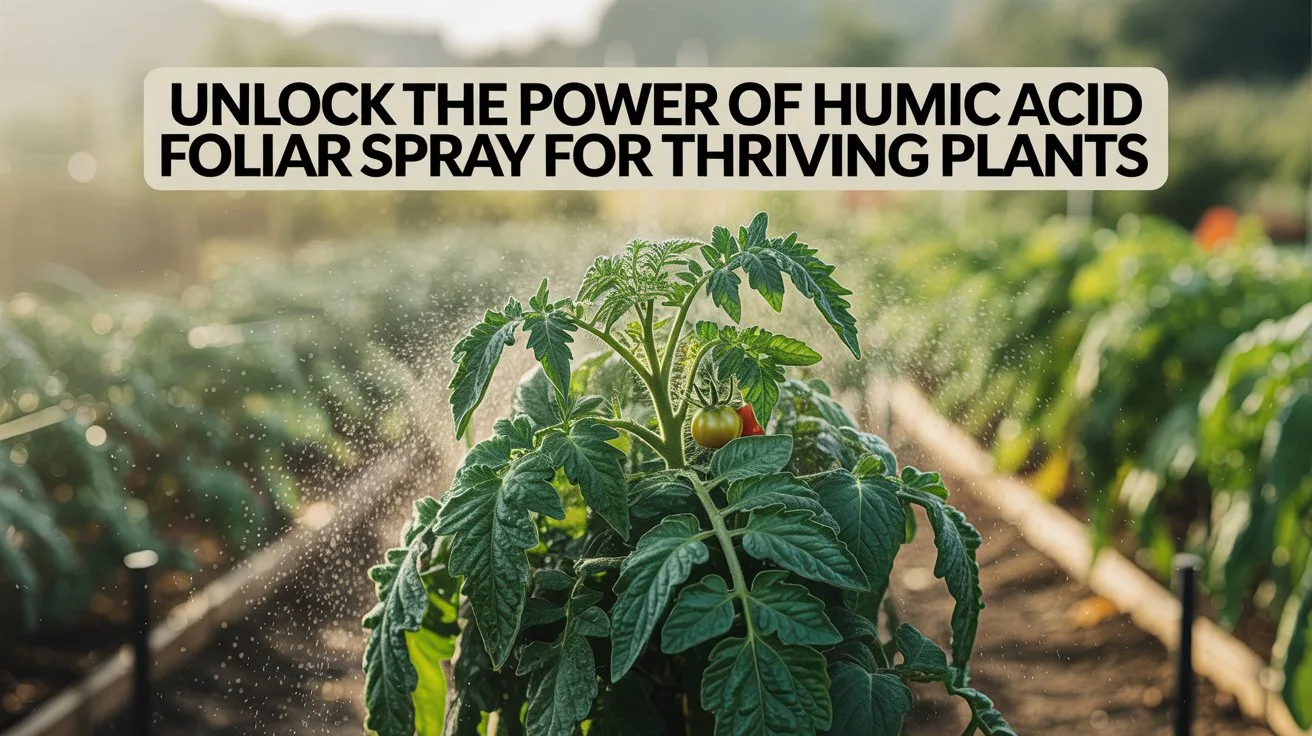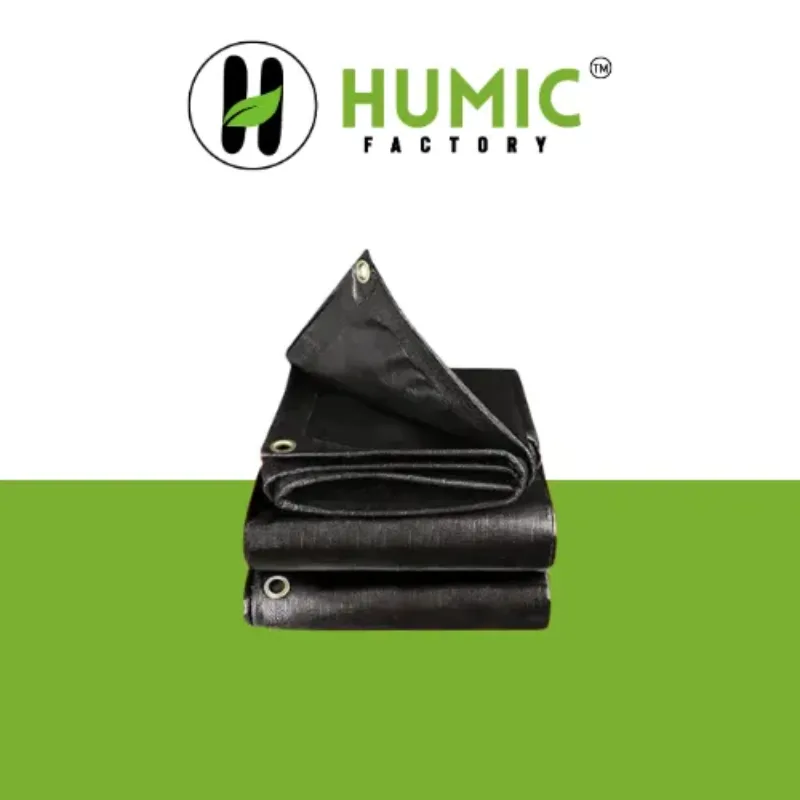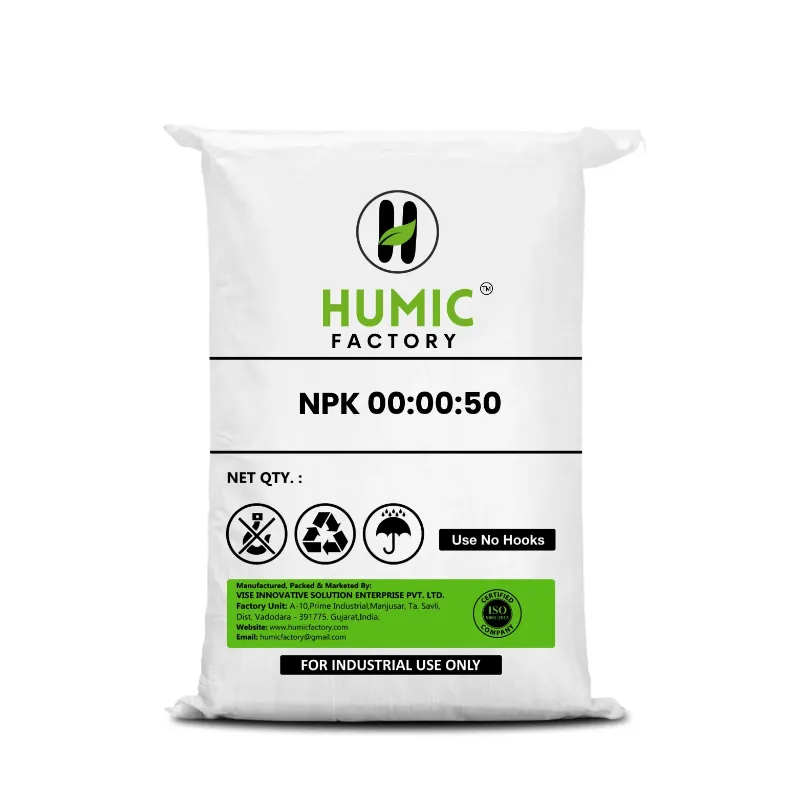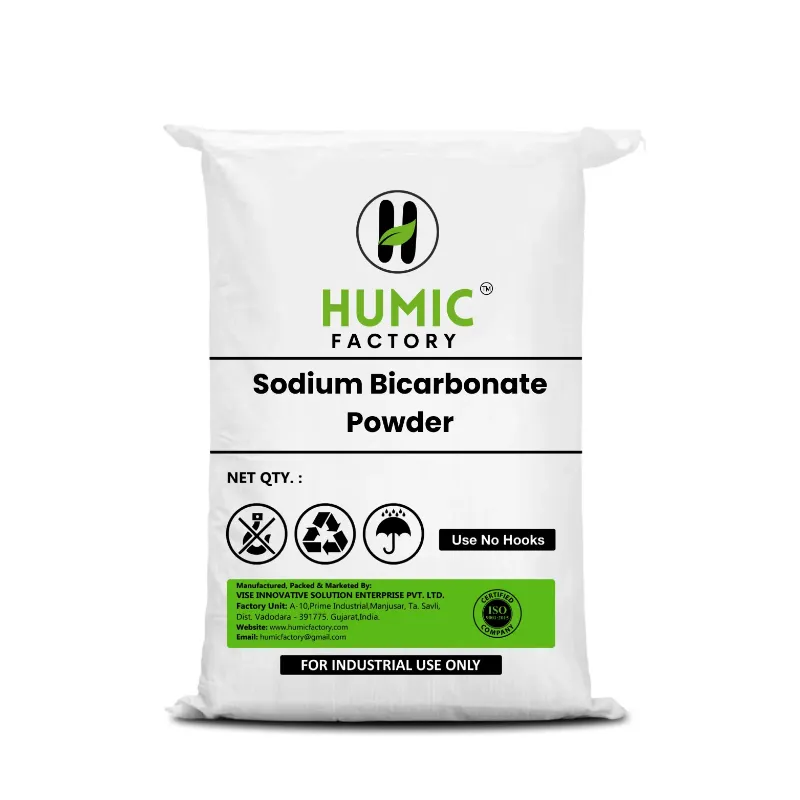Humic acid foliar spray is rapidly emerging as a popular natural solution for gardeners and farmers wishing to cultivate a stronger and, therefore, more vigorous plant growth. This organic formulation makes use of humic substances to promote healthier crops without the reliance on harmful chemical applications.
Humic acid foliar spray, which is rich in carbon-based compounds derived from natural organic matter, promotes improved nutrient absorption, when sprayed directly onto the surface of the leaves. Since foliar applications are a quicker, more efficient method of delivering important minerals such as macro and micronutrients, the plant can efficiently photosynthesize and grow healthier, without anxiety.
Foliar humic acid provides direct nutrient absorption for the plant leaves and has an immediate impact. Humic acid also bypasses soil absorption hurdles by injecting nutrients directly into the plant system. For these reasons, humic acid is more practical than soil incorporation when rapid results or as a supplement during high growth phases or nutrient deficiencies is required.
The real benefit of humic acid for foliar applications is that it is compatible in numerous types of planting environments. From vegetable gardens or ornamental landscapes to large commercial farms; foliar humic acid continues to promote a healthier plant environment, resulting in faster, more robust plant growth. Humic acid exposure helps the plants by improving chlorophyll, as well as providing a nutrient-rich environment for microbial life on the plant leaf surfaces. Humic acid foliar applications are the ultimate plant vitality enhancer.
Introduction: Why Humic Acid Foliar Spray Is a Game-Changer for Gardeners and Farmers
Humic acid foliar spray has become a leading method of rapidly improving plant health in the fast changing world of organic farming and gardening. This is an important practice because unlike the traditional application of nutrients through soil, foliar spraying delivered nutrient material to the leaves and thus will be immediately taken up to the plant's system. This technique allows growers to supply nutrients while the plant is in the proper stage of growth. Timing is critical and perhaps even more useful when the plant is in a state of stress or nutrient deficient.
With that said, let’s look at very specific advantages of foliar humic acid, what is providing the increasing popularity of this practice, and how are we improving plant health along with even better agronomic practices.
The rise of foliar humic acid in sustainable farming
- Growing Popularity: The usage of foliar humic acid is on the rise among farming professionals due to the ability to offer fast absorbing support to crops when they are in sensitive growth stages.
- Eco-Friendly: Foliar humics are in line with organic and sustainable agricultural principles as they displace the use of synthetic fertilizer.
- Wider Use Cases: We are seeing foliar humics used on any crop you can think of, leafy green vegetables, fruit or nut-bearing trees, and even turf grass.
Foliar feeding has been limited in most cases to a way of applying micronutrients, but the choice of delivering or applying humic substances in foliar form has expanded the types of nutrients that can be delivered in foliar application types, and the process humic acid in foliar form can provide for crops above and beyond fertilizer type nutrients as it retains the abilities to enhance photosynthesis , enhance microbial activity on leaf surfaces, and provide a natural boost to growth to make it useful in both conventional and organic agriculture systems.
Why humic acid for foliar spray enhances nutrient delivery
- Chelating Effect: Humic acid is a natural chelator, allowing essential nutrients to bind more readily and enter the plant.
- Fast Action: Foliar applications will have a much faster response compared to granular forms.
- Versatile Compatibility: Works with most blends of micro and macronutrients.
Humic acid's heteropolymeric chemical structure allows it to bind with agronomic nutrients like iron, calcium, and magnesium, adding to its chelation effect if you are using it for a foliar product. Humic acid will provide much more nutrients in a single application than you will get from soil application because it increases nutrient mobility and makes sure minerals are used efficiently rather than being lost in runoff or locked out by soil.
How foliar applications improve absorption speed and effectiveness
- Direct Bypass: Overcomes pH, compaction, or other soil-related issues.
- Speed of Visual Results: Plants will respond, often showing greening and additional growth, within days of treatment.
- Ideal at Time of Stress: Humic actively aids during drought, transplant shock, or during flowering.
Nutrients must travel through micro-organisms; interacting layer of moisture; tonne of soil particles; before accessing the root system when soil-applied, through to root. Humic acid applied as a foliar feed is free of these layers, accessing the plant directly to supplied nutrients in the plant tissue and foliage where you want it to go. Foliar humic acid products will show faster corrections of shortfall and provide an immediate burst of vitality when needed most, e.g. during flowering or fruiting and especially midst drought.
Comparative Snapshot: Foliar vs. Soil Application
Essentially, humic acid as a foliar spray provides an amazing addition to soil programs, because the benefits occur much faster, the crop response is much more efficient, and it supports plant efficiency with no negative effects on the environment. Whether you are a vegetable gardener or a large-scale farmer, using foliar humic acid provides the opportunity for increasing plant health, vigor, and production.
The Science Behind Humic Acid Foliar Spray
Understanding the science behind humic acid foliar spray clarifies why it has become a leading option for gardeners and farmers who want to develop healthy, vigorous plants. By using foliar application, the humic acid can avoid the problems that soil provides and provide the humic acid directly to the leaves, which speeds up the cell uptake and achieves much faster physiological responses
How humic acid interacts with leaf tissues and stomata
After applying humic acid foliar spray to plant leaves, the humic acid penetrates into the leaf usability via the stomata. The stomata are small openings that allow for gas exchange, but they also contribute to entry points for nutrients when using external solutions such as foliar humics.
Fast uptake: With foliar applications, results can happen in hours rather than through root-based feeding.
- Stomatal conductance: The supply of humic substances can enable stoma to open wider, generating higher gas exchange and transpiration levels that support better levels of metabolic activity.
- Better mobility: The fact that humic compounds are present will help chelate (bind) micronutrients. As a result, micronutrients like iron and zinc or magnesium, can move much more easily into the plant tissues and through the plant with the help of humic acid.
Once the humic acid molecules are absorbed through the stomata, they then act on the leaf tissue by creating a state of increased membrane permeability and more efficient nutrient translocation to stimulate leaf tissue. This equates to improved photosynthesis and greater energy production from that photosynthesis source, which is especially useful during the early vegetative stage or during stress periods.
Biological functions enhanced by foliar humic acid
Foliar humic acid affects many biological activity, important for plant growth and development.
- Photosynthesis activation: increases chlorophyll content and thus increases greenness and efficiency of leaves.
- Protein metabolism: promotes production of enzymes involved in key plant activity.
- Root signalling: Although applied to leaves, humic acid also stimulates chemical signals that stimulate root grow and nutrient absorption.
Humic acid positively affects system activity as well as independent leaf activity. With increases in photosynthetic efficiency and protein metabolism increases plant energy production, leading to more vigorous growth, increased resistance to pests/diseases, and uniform production of flowers or fruit. Foliar applied humic acid should be especially helpful in crops facing plant nutrient deficiencies associated with less than ideal soil.
The plant’s cellular response to humic acid for foliar spray
Plants are able to respond to humic acid for foliar spray at the cellular level in a similar manner to natural growth hormones.
Auxin-like action: Humic acids have some properties that mimic plant hormones (ex: auxins), involved in cell elongation and division. Humic acids can also improve the transport of ions, improving the plant's ability to uptake nutrients from the leaf surface.
- The much greater potential of humic acids is with improving the resilience of the plants from different abiotic stressors.
- Inducing antioxidant enzymes in plants enhances stress tolerance from heat, drought, salinity etc
- On a microscopic basis, humic acid induces genes responsible for growth and defence.
This hormone-like or action of humic acid helps to explains the uniqueness of the humic acid foliar spray as a biostimulant that does not only provide supplementation to the plants, but actually stimulates the plants into optimal achievement. Foliar humics improve cellular and physiological stimulation, with improved yield and resilience with leafy greens, fruiting plants or flowering crops.
How to Apply Humic Acid Foliar Spray for Maximum Effectiveness
To maximize the use of a humic acid foliar spray, it’s important to know the right time, ratio, and method of application. With humic acid foliar sprays, you are applying organic nutrients through the leaves of the plant allowing them to absorb the nutrients more quickly and see faster growth results.
First, start off with the time to spray. The best time to use humic acid foliar sprays is early in the morning or later in the afternoon when the sun is less intense. Spraying early morning or late afternoon will prevent you from losing product due to rapid evaporation and you will reduce the chances of burning the leaves by sunlight intensifying through wet foliage. Don’t spray in the heat of the day (midday) or right before it rains since both conditions will reduce the rate of uptake of the foliar-applied nutrients.
When and how to apply foliar humic acid during the season
- Early morning or late afternoon. Aim for cooler, low-light periods when a stomatal opening is reduced to lessen the chances of sun scorch and increase uptake.
- Every 1-2 weeks during active growth. Apply when the plant is in vegetative and flowering stages in order to ensure ease of nutrient uptake, along with maximizing photosynthesis and plant resilience.
- Avoid application under extreme heat or rain. Remember that too hot or wet conditions will decrease absorption of the humic acid application and thus, effectiveness.
Timing of applications of foliar humic acid makes a big difference. Morning or evening applications are best when temperatures are relatively cooler and stomata are closed, making the likelihood for absorption of humic substances greater. In the active growth periods such as early leaf development or bloom, it enables the plant a rapid uptake of nutrients as well. Midday heat and rain or rain about to fall, are the worst times to apply. If it rains immediately after you spray, the likelihood is that you have washed off the poetic and probably not received any positive benefit from the treatment.
Correct dilution ratios for humic acid for foliar spray
- General-use dilution: 0.05% to 0.1% solution
- Usually, this is 0.5–1 mL of concentrate per liter of water.
- Crop- or stage-specific adjustments
- Use higher rates towards flowering/fruiting - lower rates for delicate seedlings.
- Always start with a small test.
- Look for potential leaf sensitivity and to ensure you do not damage the plant with over-concentration.
For effective foliar applications, dilute your humic acid concentrate in water to a 0.05–0.1% solution - about 0.5 to 1 mL per liter. You can increase percentages during flower or fruit development, but always be more careful with young or sensitive plants. As always, pilot on a few leaves first before spraying the entire crop to make sure there are no phytotoxic effects.
Tools and techniques to ensure even leaf coverage
- Use a fine-mist sprayer
- Nebulizing nozzles produce a gentle, even mist uniformity with no drips.
- Spray 20-30 cm away
- Maintains coverage without overdosing.
- Use a non-ionic surfactant
- A small blip will allow droplets to adhere to the leaf surface and spread evenly.
- Mist both the top and bottom leaf surfaces
- Upper leaves collect sunlight; lower leaf surfaces also have stomata absorbing foliar feeds.
To maximize coverage, utilize a fine-mist sprayer with a nozzle that provides good solution atomization. Hold the fine-mist sprayer at 20-30 cm away from the foliage and be consistent with its movement as to not pool the solution. Add a tiny blip of non-ionic surfactant to your mixture so that your solution will cling to the leaves. For the best coverage, you will mist the tops and bottom of the leaves since both the upper and lower surfaces will have stomata absorbing the humic solution.
Foliar Humic Acid vs Traditional Fertilizers: What Makes It Better?
Foliar humic acid sprays provide a direct opportunity for plants to improve nutrition by delivering humic substances onto foliage. It differs from the traditional granular or liquid fertilizers we apply to soil because foliar applications eliminate many of the restrictions relating to soil, including nutrient tie-up or the resulting pH level of the soil.
There are a few differences to note:
- Speed: Nutrients are taken up in the leaves quicker than nutrients taken up in roots.
- Efficiency: Losses due to leaching to fixation, as found with soil fertilizers will be eliminated with foliar application.
- Supplementary: Foliar humic acid never contradicts soil fertilization, it promotes Soil response.
For this reason foliar humic acid can have a powerful impact as a supplementary fertilizer to any standard fertilizer program especially in regard to enhancing or optimizing total available uptake of nutrients to the plant.
Advantages over soil-only humic applications
Using humic acid for a foliar spray provides many advantages that can be missed by soil-only treatments:
- Avoids Soil Constraints: Foliars bypass the nutrient blocking effects of high pH or microbial activity in soil.
- Fast Acting: Immediate remedial impact during tough heading for drought, stress, and heat.
- Targeted Application: Smaller total volumes used makes it practical to treat seedlings, houseplants, or isolated areas in high-value crops without a costly soil amendment.
In combination as a full-folio and soil approach, we can develop a complete plan in plant management.
Compatibility with organic and synthetic fertilizers
One major advantage of foliar humic acid is it can be used in all farming systems:
- Organic Systems: Will work in combination with compost teas or natural biostimulants and improves nutrient mobilization.
- Conventional Systems: The ion exchange and chelating abilities make synthetic nitrogen, phosphorus, and potassium fertilizers work better.
- Minimal Interference: Its low salt and neutral pH means it will usually not interfere with other foliar sprays or drip-irrigation systems.
Foliar humic acid is therefore ideal for integrated nutrient programs for both conventional and non-conventional farming systems.
Long-term soil and plant health synergy
Although short-term leaf improvements sound good, long-term compatibility between foliage treatments and soil health is valuable:
- Improved Root-to-Soil Feedback Loop: Healthier leaves are a result of healthier relationships with soil and in turn those leaf secretions stimulate good soil microbes.
- Long haul improvements: Regular positive functioning of foliage via the structure you are providing from soil-based humics will produce long-lasting positive improvements in leaf function, as soils improve leaf branch systems.
- Resilience over time: Plants that are consistently fed with the 2 methods both keep them better off in drought, increased disease resistance, and allow persistent yield improvements.
Using humic acid in the foliar spray walks the grower a balance of supporting plants now while creating good stuff for the ecosystem quote today.
FAQs
Q1. What is humic acid foliar spray and how does it work?
Humic acid foliar spray is a liquid application of humic substances sprayed directly onto plant leaves. It enhances nutrient absorption through foliage, boosts chlorophyll production, and improves plant health by quickly delivering bioactive compounds.
Q2. Can foliar humic acid be used with other sprays?
Yes, foliar humic acid is compatible with most fertilizers, micronutrients, and biological sprays. Always perform a small test mix first and avoid combining it with highly acidic or alkaline solutions.
Q3. How often should I apply humic acid for foliar spray?
Apply humic acid for foliar spray every 10–14 days during active growth. For stressed or nutrient-deficient plants, weekly applications may provide better results.
Q4. Is humic acid foliar spray safe for all types of plants?
Yes, humic acid foliar spray is safe for vegetables, fruits, ornamentals, lawns, and trees. It’s organic-friendly and supports plant health without causing leaf burn when used as directed.
Q5. What’s better—foliar spray or soil application of humic acid?
Both have their strengths. Foliar humic acid offers fast-acting benefits for immediate nutrient uptake, while soil application builds long-term fertility and root health. For best results, use both together.
Conclusion: Transform Your Garden with the Proven Power of Humic Acid Foliar Spray
Using humic acid foliar spray is more than just a gardening upgrade—it’s a proven method to enhance plant vitality, improve nutrient absorption, and promote stronger, healthier growth. This organic solution delivers nutrients directly to leaves, stimulating photosynthesis and speeding up plant response compared to traditional soil applications.
Gardeners and farmers alike are increasingly turning to foliar humic acid because of its ability to support rapid plant recovery, resist environmental stress, and boost overall yield. Whether you’re growing vegetables, fruits, flowers, or turf, humic acid for foliar spray offers a natural and sustainable edge in plant nutrition.
With consistent application and proper technique, you can expect visible improvements in plant color, strength, and productivity. Embrace the science and simplicity of humic acid foliar spray and start transforming your garden into a thriving, resilient ecosystem—naturally.





